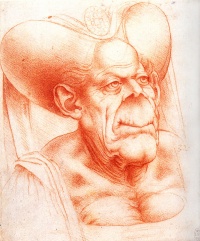The caricatures and grotesques of Leonardo da Vinci
From The Art and Popular Culture Encyclopedia
(Difference between revisions)
| Revision as of 08:34, 21 August 2011 Jahsonic (Talk | contribs) ← Previous diff |
Current revision Jahsonic (Talk | contribs) |
||
| Line 1: | Line 1: | ||
| [[Image:Grotesque head by Da Vinci.jpg|thumb|right|200px|''[[Grotesque Head]]'' (c. [[1480]]-[[1510]]) by [[Leonardo da Vinci]], clearly the inspiration for ''[[The Ugly Duchess]]'']] | [[Image:Grotesque head by Da Vinci.jpg|thumb|right|200px|''[[Grotesque Head]]'' (c. [[1480]]-[[1510]]) by [[Leonardo da Vinci]], clearly the inspiration for ''[[The Ugly Duchess]]'']] | ||
| {{Template}} | {{Template}} | ||
| + | Italian artist [[Leonardo da Vinci]]'s extensive collection of [[The drawings of Leonardo da Vinci|drawings]] feature a large number of [[caricature]]s and [[grotesque]]s. | ||
| - | :"[[Gargoyle]]s were the complement to saints; [[Leonardo's caricatures]] were complementary to his untiring search for ideal beauty. And gargoyles were the expression of all the passions, the animal forces, the [[Caliban]] gruntings and groanings which are left in human nature when the divine has been poured away. Leonardo was less concerned than his Gothic predecessors with the ethereal parts of our nature, and so his caricatures, in their expression of passionate energy, merge imperceptibly into the heroic."--[[Kenneth Clark]] | + | English art critic Kenneth Clark said about these in 1939: |
| - | ==See also== | + | |
| + | :"[[Gargoyle]]s were the complement to saints; [[Leonardo's caricatures]] were complementary to his untiring search for [[ideal beauty]]. And gargoyles were the expression of all the passions, the animal forces, the [[Caliban]] gruntings and groanings which are left in human nature when the divine has been poured away. Leonardo was less concerned than his Gothic predecessors with the ethereal parts of our nature, and so his caricatures, in their expression of passionate energy, merge imperceptibly into the heroic."--''Leonardo da Vinci'' (1939), [[Kenneth Clark]] | ||
| + | ==Reference== | ||
| + | *''[[Recueil de testes de caractere et de charges dessinees par Leonard de Vinci florentin]]'' (1730), perhaps the first anthology of this kind of work by Leonardo | ||
| + | ==Examples== | ||
| + | |||
| + | *[[Five grotesque heads]] | ||
| + | *[[Grotesque Heads]] | ||
| + | *[[Grotesque Head]] | ||
| *[[Study for a Caricature (Leonardo, Milan)]] | *[[Study for a Caricature (Leonardo, Milan)]] | ||
| + | ==See also== | ||
| *[[The drawings of Leonardo da Vinci]] | *[[The drawings of Leonardo da Vinci]] | ||
| + | *[[Grotesque art]] | ||
| + | *[[Michelangelo on the grotesque]] | ||
| + | ==External links== | ||
| + | *http://commons.wikimedia.org/wiki/Category:Caricatures_by_Leonardo_da_Vinci | ||
| {{GFDL}} | {{GFDL}} | ||
Current revision
|
Related e |
|
Featured: |
Italian artist Leonardo da Vinci's extensive collection of drawings feature a large number of caricatures and grotesques.
English art critic Kenneth Clark said about these in 1939:
- "Gargoyles were the complement to saints; Leonardo's caricatures were complementary to his untiring search for ideal beauty. And gargoyles were the expression of all the passions, the animal forces, the Caliban gruntings and groanings which are left in human nature when the divine has been poured away. Leonardo was less concerned than his Gothic predecessors with the ethereal parts of our nature, and so his caricatures, in their expression of passionate energy, merge imperceptibly into the heroic."--Leonardo da Vinci (1939), Kenneth Clark
Contents |
[edit]
Reference
- Recueil de testes de caractere et de charges dessinees par Leonard de Vinci florentin (1730), perhaps the first anthology of this kind of work by Leonardo
[edit]
Examples
[edit]
See also
[edit]
External links
Unless indicated otherwise, the text in this article is either based on Wikipedia article "The caricatures and grotesques of Leonardo da Vinci" or another language Wikipedia page thereof used under the terms of the GNU Free Documentation License; or on research by Jahsonic and friends. See Art and Popular Culture's copyright notice.


